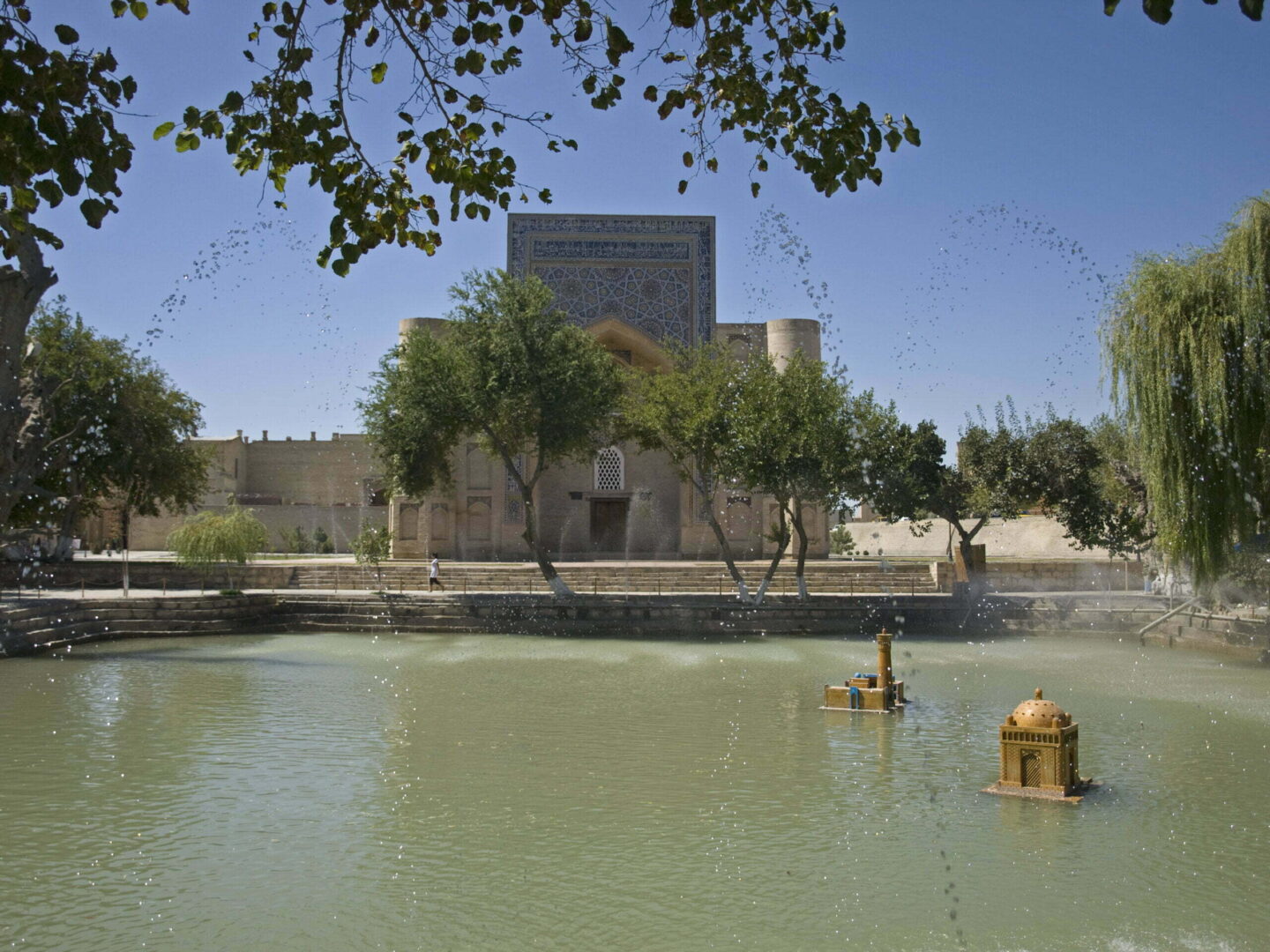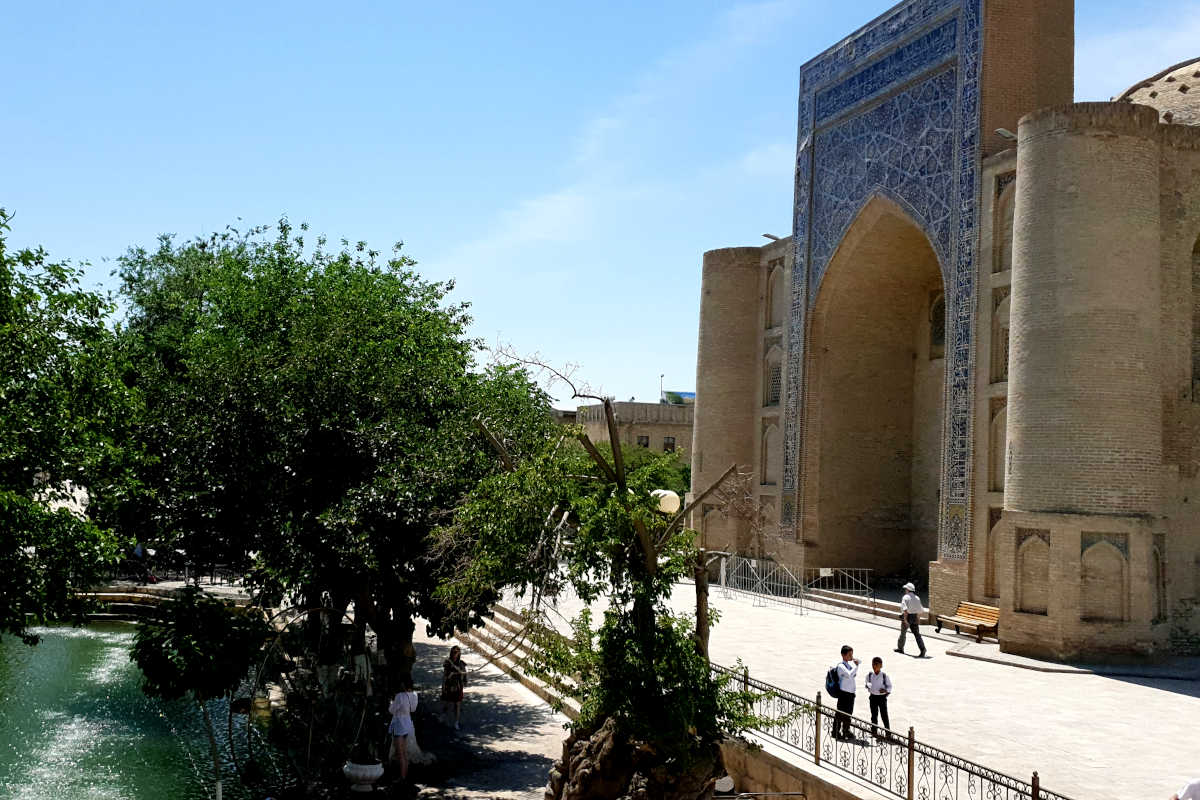Bukhara - Labi Havuz ensemble

The Labi Havuz ensemble in Bukhara: a masterpiece of Central Asian architecture
The Labi Havuz ensemble in Bukhara, built in the 17th century, is one of the most impressive examples of Central Asian architecture. Three buildings – the Kukaldash Madrasah (1568-1569), the Khonaqoh Nadir Divanbegi (1622) and the Nadir Divanbegi Madrasah – together form this unique complex, the centrepiece of which is the Labi Havuz, a large water basin. This architectural jewel not only reflects the master craftsmanship of the time, but also the social and cultural significance of such ensembles in the region.
The Kukaldash madrasah: a monument to knowledge and spirituality
The oldest part of the ensemble is the Kukaldash madrasah, which, with its 160 cells, is considered the largest of its kind in Bukhara. Its architecture conveys an impression of narrowness and overcrowding, characterised by narrow corridors, steep stairs and winding passages. Yet despite this pragmatic interior design, the madrasah reveals remarkable architectural details: the massive domed ceilings in the corridors leading to the gates are evidence of solid architecture, while the main halls of the mosque and the darskhana (teaching hall) are ornately decorated. Particularly impressive are the carved wooden doors, whose complex star patterns reveal the virtuosity of the woodcarvers of the time.
The water collection basin: Centre of life and refreshment
The ensemble took on its final form with the construction of the large Havuz, the water basin that gave the complex its name. The banks of the basin were fortified with mighty stone blocks, on whose ledges the so-called meshkaben – water carriers whose services were used by the population – descended to fetch water. The water from the Havuz was not only used to supply drinking water, but also to irrigate the roads and for building purposes. To this day, picturesque, centuries-old trees that line the basin lend the complex a special atmosphere of calm and coolness.
The Nadir Divanbegi Madrasah: elegance and symbolism
The Nadir Divanbegi Madrassa was built shortly after the completion of the water basin. The harmonious proportions of its façade and the artistic depictions of fallow deer and fantastic birds in the arches bring the beauty and symbolic power of Central Asian architecture to life. The courtyard area of the madrasah once served as a place of rest and study, reflecting the elegance and harmony that was sought in the architecture of that era.
What is particularly remarkable about the Labi Havuz ensemble is the successful integration of the large water mirror into the monumental building complex. Instead of a traditional square, the water basin functions as a central element that connects the various buildings. This architectural solution was not only aesthetically innovative, but also provided a pleasant source of freshness in the hot summer months of Bukhara.
Legends and myths: the origins of the Labi Havuz
The Labi Havuz not only harbours architectural treasures, but also legends and myths. According to one story, there was originally a large house belonging to a Jewish widow on the site of today’s pool. Nadir-Divan-Begi, who had the Khonaqoh built, recognised the strategic value of the land for the construction of a water reservoir. Despite generous offers, the widow refused to sell her property. Determined to realise his plan anyway, Nadir-Divan-Begi resorted to a ruse: he had the property flooded by artificial means so that the widow was finally forced to give up her land. The result was the Labi Havuz, which today is not only recognised as an architectural masterpiece, but also bears the turbulent history and myths of Bukhara.

A place of historical depth and architectural beauty
The Labi Havuz ensemble is far more than just a collection of historical buildings – it is a living testimony to the cultural, social and architectural development of Central Asia. The harmonious combination of water, stone and ornamentation makes this place a symbol of Bukhara’s history and a centre of attraction for visitors from all over the world. Even today, the calm waters of the Havuz reflect the past, while the old trees provide shade and seem to whisper stories from a distant past.
